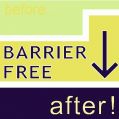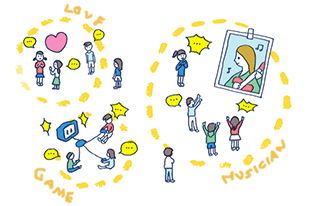|
|
|
|
コメント(10)
AC TRANSITのサイトで関連する内容をまとめました。。。
(英語でごめんなさい)
http://www.actransit.org/customer/transit_glossary.wu
ADA
(Americans With Disabilities Act)
Refers to Federal civil rights legislation passed in 1990 that requires public transportation services to be accessible to, and usable by, persons with disabilities. In compliance, AC Transit operates a bus fleet equipped with passenger lifts and wheelchair tie-downs, and also operates parallel paratransit service for those who cannot use the fixed-route bus system.
Low-floor vehicle
Refers to a bus that does not have steps. Building a bus floor at one level between the front to rear doors allows passengers to enter and exit more quickly. The addition of steps usually adds boarding and alighting time, especially for passengers with limited mobility.
Kneeling bus
Refers to a feature on all buses that lowers the floor to the curb or to near-curb level to make it easier for passengers to board, especially for seniors and persons with disabilities. AC Transit provides special "Flash Cards" upon request to allow riders to quickly request this assistance when boarding.
Passenger lift
A mechanical device, either a lift or ramp, that allows wheelchair or scooter users, as well as other mobility-impaired passengers, to board a bus without climbing the steps. By law, passenger lifts must be capable of lifting at least 600 pounds.
(英語でごめんなさい)
http://www.actransit.org/customer/transit_glossary.wu
ADA
(Americans With Disabilities Act)
Refers to Federal civil rights legislation passed in 1990 that requires public transportation services to be accessible to, and usable by, persons with disabilities. In compliance, AC Transit operates a bus fleet equipped with passenger lifts and wheelchair tie-downs, and also operates parallel paratransit service for those who cannot use the fixed-route bus system.
Low-floor vehicle
Refers to a bus that does not have steps. Building a bus floor at one level between the front to rear doors allows passengers to enter and exit more quickly. The addition of steps usually adds boarding and alighting time, especially for passengers with limited mobility.
Kneeling bus
Refers to a feature on all buses that lowers the floor to the curb or to near-curb level to make it easier for passengers to board, especially for seniors and persons with disabilities. AC Transit provides special "Flash Cards" upon request to allow riders to quickly request this assistance when boarding.
Passenger lift
A mechanical device, either a lift or ramp, that allows wheelchair or scooter users, as well as other mobility-impaired passengers, to board a bus without climbing the steps. By law, passenger lifts must be capable of lifting at least 600 pounds.
All AC Transit buses are equipped with the following accessibility features:
http://www.actransit.org/riderinfo/accessibility.wu
Passenger lifts or ramps (for wheelchair/mobility aid users, or anyone who has trouble climbing steps)
"Kneeling", which lowers the first step several inches to make the first step easier (note: special "Flash Cards" are available upon request from AC Transit, which passengers can display prior to boarding, for requesting lift or kneeler)
Priority Seating near the front of buses, for persons with disabilities and seniors
Two wheelchair securement locations per bus, each equipped with securement devices which hold the wheelchair safely in place, and are required for all wheelchair users. Drivers provide securement assistance as needed. Also provided are lap/shoulder belts which wheelchair users can request, along with assistance from driver.
A special Wheelchair Marking/Tether Strap program is also available for identifying/providing proper securement points on wheelchairs
Stop announcements at major intersections and transfer points, provided either verbally by drivers, or by automated equipment.
http://www.actransit.org/riderinfo/accessibility.wu
Passenger lifts or ramps (for wheelchair/mobility aid users, or anyone who has trouble climbing steps)
"Kneeling", which lowers the first step several inches to make the first step easier (note: special "Flash Cards" are available upon request from AC Transit, which passengers can display prior to boarding, for requesting lift or kneeler)
Priority Seating near the front of buses, for persons with disabilities and seniors
Two wheelchair securement locations per bus, each equipped with securement devices which hold the wheelchair safely in place, and are required for all wheelchair users. Drivers provide securement assistance as needed. Also provided are lap/shoulder belts which wheelchair users can request, along with assistance from driver.
A special Wheelchair Marking/Tether Strap program is also available for identifying/providing proper securement points on wheelchairs
Stop announcements at major intersections and transfer points, provided either verbally by drivers, or by automated equipment.
お寒うございます
以前、交通権学会誌に、車いす利用者の公共交通利用運動の「通史」を書いたことがあります
「身体障害者の公共交通機関利用権確立運動 ―1970年代を中心に― 」
http://www.kotsuken.jp/journal/journal23.html
全文は http://ci.nii.ac.jp/els/110009607509.pdf?id=ART0010070860&type=pdf&lang=jp&host=cinii&order_no=&ppv_type=0&lang_sw=&no=1389738721&cp=
その他の論文一覧が
http://ci.nii.ac.jp/author?q=%E6%A3%AE+%E3%81%99%E3%81%90%E3%82%8B
どうぞ、参考になさってください
以前、交通権学会誌に、車いす利用者の公共交通利用運動の「通史」を書いたことがあります
「身体障害者の公共交通機関利用権確立運動 ―1970年代を中心に― 」
http://www.kotsuken.jp/journal/journal23.html
全文は http://ci.nii.ac.jp/els/110009607509.pdf?id=ART0010070860&type=pdf&lang=jp&host=cinii&order_no=&ppv_type=0&lang_sw=&no=1389738721&cp=
その他の論文一覧が
http://ci.nii.ac.jp/author?q=%E6%A3%AE+%E3%81%99%E3%81%90%E3%82%8B
どうぞ、参考になさってください
- mixiユーザー
- ログインしてコメントしよう!
|
|
|
|
バリアフリーについて考える 更新情報
-
最新のアンケート
-
まだ何もありません
-
バリアフリーについて考えるのメンバーはこんなコミュニティにも参加しています
人気コミュニティランキング
- 1位
- 暮らしを楽しむ
- 77430人
- 2位
- 写真を撮るのが好き
- 209453人
- 3位
- 空を見上げるのが好き
- 139113人
























